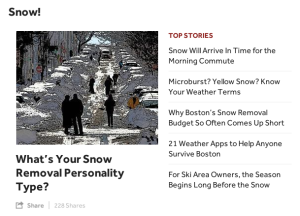At the end of the semester, Boston.com still has quite a few improvements to make. While the content is good, the transitory period of the media organization is blatantly apparent. The website struggles to load the massive amounts of data on each page. Links sometimes don’t work. Navigation bars change frequently, making it difficult to revisit articles without the URL.
Perhaps the Crime Section–if you are willing to call it a “section”–is the best example of common traits of Boston.com. It is a subset of the home page, with a link to the “Crime” section, but it lacks designation on the navigation bar or within the News section. Although crime rates in Boston have generally been falling, Boston.com is fairly swift to report on local events and are often post stories on social media accounts.
However, the crime section lacks true definition. After being on the page for a few minutes, the Crime page automatically refreshes and returns viewers to the home page. If it is even considered a category, it needs to be better defined by having its own page with posts solely dedicated to crime. (Sometimes, the posts under “Crime” aren’t about crime.) Although stories tend to have images on the individual pages, these photos or videos often do not show up on the preview.
I maintain my suggestion that a web development overhaul for Boston.com is necessary. Although navigation and functional links have improved, the number of issues that remain overshadow the progress. The site would benefit from more visual elements on the top of the page instead of the bottom. Removing some of the data from pages would greatly increase the ability of users to load pages they want to read.
I’m disappointed that I could copy and paste a good chunk of my initial review of Boston.com on my conclusions. Despite the significant progress over the past few months, Boston.com still needs a good amount of reworking and defining in order to solidify it as a functional and independent media outlet.












